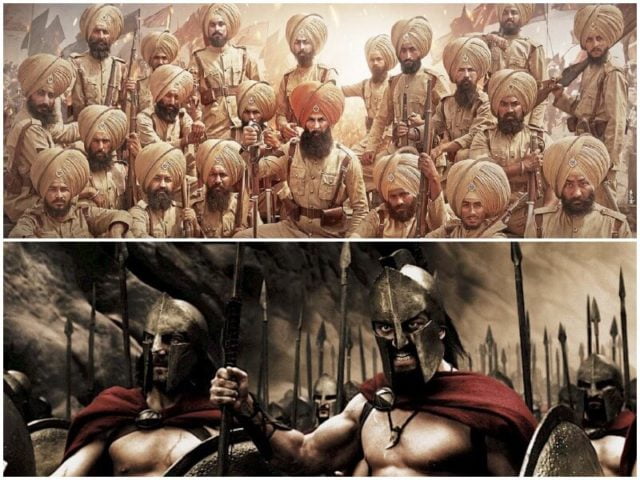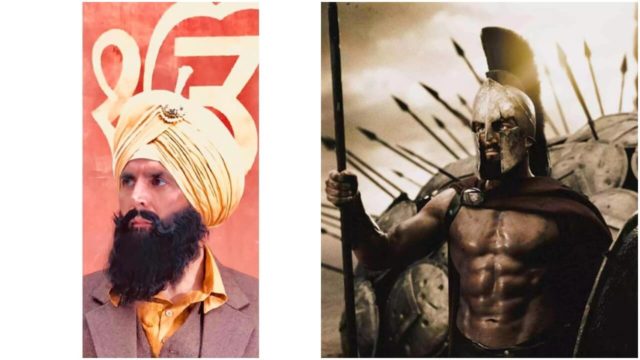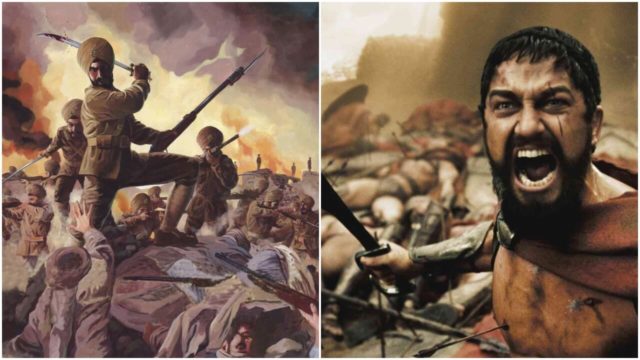Akshay Kumar’s upcoming film ‘Kesari’ is not that far from release, but upon reading about the event it is based on, an interesting observation arose.
Apparently, as per historians, the story Kesari is based on, that is the iconic Battle of Saragarhi is often taken as the Indian version of 300.
People might know 300 as the 2006 historical-fantasy Hollywood film starring Gerard Butler based on the ancient Battle of Thermopylae, but the situation of a small group of soldiers fighting a large enemy is also seen in our very own desi Battle of Saragarhi.
It is truly a shame that not many people know of this iconic battle where 21 Sikh soldiers faced with bravery and determination against more than 10,000 Afghans.
However, the fact that a movie is being based on this battle leads us to think that we can finally have our own, and hopefully better, Indian version of 300.

And there are a lot of similarities between the stories of these 2 events:
#1. Both Have An Inspiring Leader
Where 300 or the Battle of Thermopylae had the King Leonidas, here we have Havildar Ishar Singh.
King Leonidas in the movie was shown as a brave and courageous King and soldier who would do anything for his subjects and not bend in the face of the enemy.
Havildar Ishar Singh too gave us such an icon to look up to and admire, where he even went to the length of sending his troop to the inner walls of the posting and decided to face the enemy on his own.
There are certain historical reports that vary between Ishar Singh being alone or having 2-3 other soldiers also with him, with the rest of the platoon protecting the heliograph and themselves in the inner part of the Saragarhi post.
However, it does not take away from the bravery that Singh showed as a leader protecting his men and taking on the enemy even if it meant he could lose his life.

Read More: Andaman Islands Fought The Battle For Independence Too And Here’s What History Books Never Tell
#2. A Small Army Facing A Big Enemy
It is truly inspiring, the basic concept of both the battles where a small army is facing a big enemy. However, the Hollywood movie did twist facts slightly, by not showing the 700 Thespian soldiers and the initial 7,000 Greek soldiers that fought against an army of almost 100,000 to 150,000 Persian army.
In the Battle of Saragarhi that was fought on 12th September 1897, there were only 21 Sikh soldiers who fought against an army of almost 10,000 Afghans from 9 am in the morning till almost 3.30 pm in the afternoon without any backup.
That is almost 6 and a half hours of fighting from a regiment that had limited number of ammunition, and just a handful of soldiers in a post that could hold almost 40 soldiers. On that fated day though, the Saragarhi post only had 21 soldiers.

#3. Both Have A Messenger
In the 300 movie we had Dilios a Spartan soldier, whom Butler’s character of Leonidas sent back halfway through the war so that he could spread the “tale of victory”.
The character was initially fighting along with the rest of the Greek army, but apparently after he lost an eye, he was sent home in order to make sure that this particular story was told to everyone.
In the Battle of Saragarhi too, we had Sepoy Gurmukh Singh, who was the one manning the heliograph and sending messages to their superiors at the nearby fort of Lockhart.

Once the fight reached the inner walls, Gurmukh Singh signaled to Fort Lockhart one last time, giving the message of, “MAIN GATE BREACHED, DOWN TO ONE… REQUEST PERMISSION TO DISMOUNT AND JOIN THE FIGHT.”
He got the reply as “PERMISSION GRANTED” and with that, he packed up the heliograph systematically in the leather case, picked up his rifle and joined into the fight.
The youngest of all the 21 Sikhs fighting, he was the last to join the battle, but once he did with the battle cry of “JO BOLEY SO NIHAL SAT SRI AKAL”, he managed to take down almost 20 enemy all on his own before succumbing to death.
While one could say that Kesari could be the Indian 300, I
believe that the Battle of Saragarhi is might more inspiring that is also invoking
national pride in a non-jingoistic way.
Image Credits: Google
Find the blogger @chirali_08
Other Recommendations:































